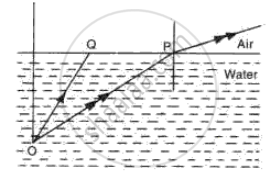Advertisements
Advertisements
प्रश्न
A ray of light incident parallel to the principal axis of a lens, passes undeviated after refraction.
विकल्प
True
False
उत्तर
This statement is false.
APPEARS IN
संबंधित प्रश्न
A ray of light after refraction through a lens emerges parallel to the principal axis of the lens. The incident ray either passes through ______.
Study the diagram shown in the following Figure.
Name the lens LL’ and draw its outline.

For an object placed at a distance 20 cm in front of a convex lens, the image is at a distance 20 cm behind the lens. The focal length of the convex lens is ______.
State the condition of the following:
A ray passes undeviated through the lens.
(a) Draw a sketch to show how a lens is able to produce an image of the sun on a paper screen.
(b)(i) Would you regard the rays from the sun as being divergent, parallel or convergent?
(ii) What is the name given to the point where such rays meet after they have passed through the lens?
(iii) How does the image of the sun sometimes burn a paper screen?
Make the correct choices in the following items :
The image formed by a diverging lens, shown in fig, , is

Fig. shows two rays of light Op and OQ coming from an object at the bottom of a pond, incident on the water surface.

(a) Mark on the diagram
(i) The angle of incidence of ray OP,
(ii) The angle of refraction of ray Op,
(iii) The position of image of the object as seen from above.
(iv) An approximate path of the ray OQ.
(b) Explain, why do the rays of light change directions on passing from water to air.
(c) A fish in water sees everything outside the water by rays of light entering its eye in a small cone of light. Draw a diagram and explain how does this happen.
A lens forms the image of an object placed at a distance of 45 cm from it on a screen placed at a distance 90 cm on the other side of it. Name the kind of lens.
How will you differentiate between a convex and a concave lens by looking at a printed page?
